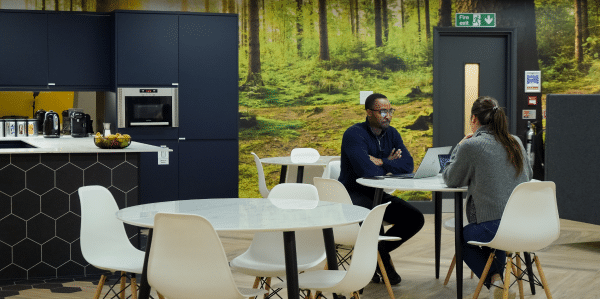It’s easy to underestimate the importance of lighting in the workplace as there is a temptation to view it as simply illuminating a space and nothing more. However, according to the UK Health and Safety Executive (HSE), when lighting is done well, it plays a vital role in supporting the well-being, safety and productivity of office workers.
Lighting for optimum office productivity hinges on creating a work environment that minimises discomfort, eye strain, and fatigue. When done poorly, office lighting can cause health problems including headaches, irritability and lack of focus, all of which will impact productivity.
Beyond physical symptoms, below-par office lighting can cause stress and increase sick days, therefore it is a vital component of workplace productivity and well-being. It is also your duty as an employer to ensure that lighting at work doesn’t pose a health risk.
Key principles of good office lighting
The HSE Lighting at Work study stresses that lighting must enable staff to carry out their work safely and efficiently and suggests the following measures to ensure optimum lighting –
- Task-specific lighting – lighting should be adapted for specific tasks, for example, those working at a computer terminal benefit from indirect, evenly diffused lighting that reduces screen glare. Using localised lighting for reading or writing can also be of benefit
- Uniformity and balance – lighting should be evenly distributed across the workspace because a sudden shift from bright to dim can cause eye strain. According to the HSE, the transition between areas should maintain a ratio of no more than 5:1 in illumination.
- Avoid glare and flicker – glare from light fittings or screens, and flickering fluorescent lights, is distracting and can trigger headaches. Diffusers and high-frequency electronic ballasts can be used to reduce these issues.
- Use of natural light – numerous studies have shown that natural light is good for us, but it needs to be managed in an office environment. Bright sunlight can cause glare and too much heat. Using blinds or adjustable window treatments can help maintain the correct levels of natural light.
- Adjustability – when it comes to office lighting, one size doesn’t fit all. Employees are happiest when they can adjust the lighting in their workstations. Desk lamps are an easy way to give them some lighting autonomy.
Optimum lighting for office settings
The following types of lighting are considered the best choice for office space –
- LED Lighting – energy-efficient and long-lasting, LEDs provide bright, consistent light without flicker and are therefore ideal for general ambient lighting.
- Desk lamps – desk lamps with adjustable arms and dimming features enable workers to adjust their lighting.
- Indirect lighting: directing light upward or diffusing it evenly across ceilings reduces shadows and provides the most comfortable lighting for office efficiency.
Lighting design considerations
When it comes to designing or upgrading lighting for your office space, consider the following –
- Colour temperature – Cool white light (4000K to 5000K) mimics daylight and enhances focus making it the best choice for office space.
- Illuminance levels – the HSE suggests that office-based tasks require an average illuminance of 200-500 lux, with a minimum of 100-200 lux.
- Reflection: reflect and spread light effectively with light-coloured walls and surfaces. This reduces the need for intense lighting.
Lighting to avoid
Some bulbs can expose people to significant infrared and ultraviolet light and should be avoided where possible. These include –
- Tungsten halogen lamps – they can become very hot and can give off harmful amounts of ultraviolet radiation. They should be fitted with an ultraviolet filter.
- High-density discharge lamps – these should be fitted with a safety shield to reduce ultraviolet radiation exposure.
- High-powered lamps – high-powered lamps such as those used in broadcast or theatre, should only be used when health and safety information from the supplier is followed at all times.
Lighting maintenance and monitoring
Office lighting productivity isn’t something you can set up and leave. It requires regular maintenance to ensure that it continues to perform well. Dirty and/or broken light fittings can seriously impact light output. The HSE recommends regular cleaning and bulb replacement.
Regular monitoring of workplace lighting can also highlight areas that need improvement and you should encourage staff to report any flickering, glare, or dim areas
Involve employees in lighting decisions
You should involve employees in all lighting decisions, conduct regular assessments, and be open to making changes that will improve office lighting. Sometimes, you need only simple steps such as rearranging desks, changing blinds, or upgrading bulbs to make a big difference.
Conclusion
By following the above suggestions and ensuring that lighting maximises employee comfort across all departments, you will support health and well-being and increase productivity. Lighting is not an area that you can afford to overlook. Invest in it and your organisation will reap the rewards.

Alice has over 10 years experience within the HR sector, understanding
changing demands of employees and creating strategies to attract and retain
employees, creating a productive and positive working environment.
You may also like...
Contact Us
Speak to one of our team today who would
be delighted to provide you with information,
discuss your requirements or book in a
viewing to see the office space for yourself.


